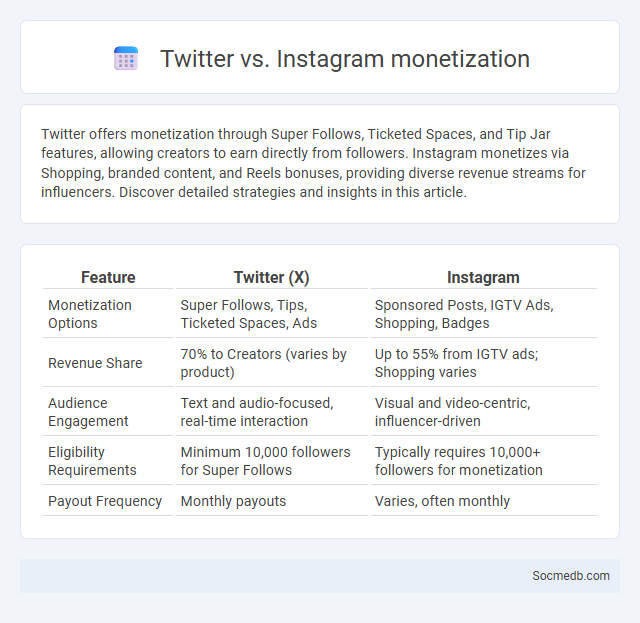
Photo illustration: Twitter vs Instagram monetization
Twitter offers monetization through Super Follows, Ticketed Spaces, and Tip Jar features, allowing creators to earn directly from followers. Instagram monetizes via Shopping, branded content, and Reels bonuses, providing diverse revenue streams for influencers. Discover detailed strategies and insights in this article.
Table of Comparison
| Feature | Twitter (X) | |
|---|---|---|
| Monetization Options | Super Follows, Tips, Ticketed Spaces, Ads | Sponsored Posts, IGTV Ads, Shopping, Badges |
| Revenue Share | 70% to Creators (varies by product) | Up to 55% from IGTV ads; Shopping varies |
| Audience Engagement | Text and audio-focused, real-time interaction | Visual and video-centric, influencer-driven |
| Eligibility Requirements | Minimum 10,000 followers for Super Follows | Typically requires 10,000+ followers for monetization |
| Payout Frequency | Monthly payouts | Varies, often monthly |
Introduction to Social Media Monetization
Social media monetization involves transforming your online presence into a revenue-generating asset by leveraging platforms like Instagram, YouTube, and TikTok. Key strategies include affiliate marketing, sponsored content, and ad revenue sharing, enabling content creators to capitalize on their audience engagement. Understanding algorithm dynamics and audience analytics is essential to maximize your earning potential in the evolving digital landscape.
Overview of Twitter’s Monetization Features
Twitter offers multiple monetization features such as Super Follows, which allows creators to charge subscribers for exclusive content, and Twitter Spaces, enabling live audio conversations with ticketed access. You can also earn through Twitter Ads and the Tip Jar feature, facilitating direct payments from followers. These tools help content creators and businesses generate revenue while expanding their audience engagement.
Instagram’s Monetization Tools for Creators
Instagram offers various monetization tools for creators, including IG Shopping, branded content partnerships, and paid badges during live videos. The platform's Instagram Creator Studio provides detailed analytics and monetization insights to help creators optimize revenue streams. Features like affiliate links and Reels bonuses further enhance earnings potential for content creators.
Eligibility Requirements on Twitter vs Instagram
Twitter requires users to be at least 13 years old and comply with its policies for account creation, including valid email or phone verification. Instagram also mandates a minimum age of 13, emphasizing authentic identity verification and restricting false information during sign-up. Both platforms enforce eligibility criteria to ensure user safety and platform integrity but differ slightly in verification methods and content guidelines.
Revenue Streams Comparison: Twitter vs Instagram
Twitter generates revenue primarily through advertising products like promoted tweets, accounts, and trends, leveraging its real-time, text-centric platform to attract advertisers focused on timely engagement. Instagram, owned by Meta, drives higher revenue through diversified streams including in-feed photo and video ads, Stories ads, Shopping features, and influencer partnerships, capitalizing on its visual appeal and user engagement for e-commerce integration. When evaluating your marketing budget, understanding these distinct revenue models helps you choose the platform that aligns best with your brand's engagement goals and monetization strategy.
Creator Earnings Potential on Both Platforms
Social media platforms like YouTube and TikTok offer significant creator earnings potential through various monetization options such as ad revenue, brand partnerships, and fan support. YouTube provides more stable income via its Partner Program, which includes revenue sharing from ads, channel memberships, and Super Chats, while TikTok focuses heavily on influencer collaborations and creator funds to boost earnings. Maximizing your content's reach on both platforms can enhance your revenue streams and grow your personal brand effectively.
Engagement Strategies for Maximizing Income
Effective engagement strategies on social media, such as interactive content, personalized messaging, and timely responses, significantly boost follower interaction and drive higher conversion rates. Utilizing platform-specific features like Instagram Stories polls, TikTok challenges, and Twitter threads enhances audience participation and brand visibility. Leveraging data analytics to tailor content and optimize posting schedules maximizes revenue potential through increased user engagement and customer loyalty.
Platform Algorithm Impact on Monetization
Social media platform algorithms significantly influence monetization by determining content visibility and user engagement rates. Algorithms prioritize certain types of posts based on user interactions, which directly affects advertising revenue and creator earnings. Understanding and adapting to these algorithmic changes enhances the potential for higher income through targeted content strategies and optimized audience reach.
Brand Partnerships and Sponsorship Opportunities
Social media platforms offer extensive brand partnership and sponsorship opportunities by connecting Your business with targeted audiences through influencer collaborations and sponsored content. Leveraging data analytics and engagement metrics enhances campaign effectiveness, driving higher brand visibility and ROI. Strategic alliances on social media amplify brand credibility and expand market reach in competitive digital landscapes.
Choosing the Best Platform for Creator Monetization
Choosing the best social media platform for creator monetization depends on your content type, audience demographics, and revenue options like ad revenue, sponsorships, or fan support. Platforms like YouTube offer robust monetization through ads and memberships, while TikTok and Instagram provide brand collaboration opportunities and creator funds. Understanding your niche and engagement patterns helps maximize your earning potential on the ideal social site.
 socmedb.com
socmedb.com